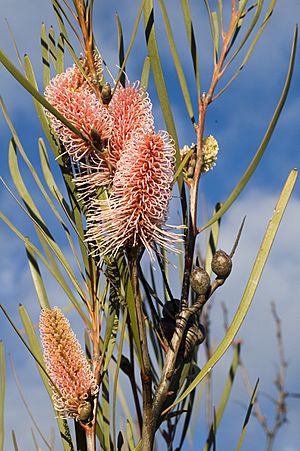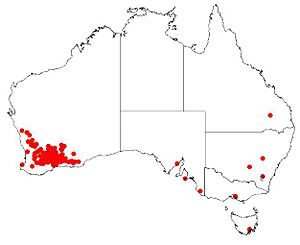Grass-leaved hakea facts for kids
Quick facts for kids Grass-leaf hakea |
|
|---|---|
 |
|
| Hakea multilineata growing near Lake King | |
| Scientific classification | |
| Genus: |
Hakea
|
| Species: |
multilineata
|
 |
|
| Occurrence data from AVH | |
The Grass-leaf Hakea (scientific name: Hakea multilineata) is a beautiful shrub. It belongs to the Proteaceae plant family. This special plant only grows in certain parts of Western Australia. You can find it in the Wheatbelt and Goldfields-Esperance areas. It has pretty pink to red flowers that grow in long clusters. Its leaves are long and feel a bit like leather.
Contents
What is Grass-leaf Hakea Like?
The Grass-leaf Hakea is an upright shrub. It usually grows to be about 1.5 to 6 metres (5 to 20 ft) tall. This plant does not have a special woody swelling at its base called a lignotuber.
Its flowers bloom from June to September. They are a bright pink color. These vibrant flowers are known for attracting local birds, which love their nectar. The Grass-leaf Hakea is an evergreen plant. This means it keeps its leaves all year round. It can be a great addition to backyards and gardens.
The leaves are a mid-green color. They are flat, wide, and long, measuring about 10–20 cm (4–8 in) long and up to 1.5 cm (0.6 in) wide. You can see clear lines, or veins, running along the leaves. The tip of each leaf is rounded.
After flowering, the plant produces smooth fruits. These fruits are shaped like an egg and get narrower towards a small point, like a beak. You might find them growing in groups or spread out along the branches. The Grass-leaf Hakea can handle light frosts. It grows best in a sunny spot with soil that drains water very well.
Where Did its Name Come From?
The Grass-leaf Hakea was first officially described in 1848. A Swiss botanist named Carl Meisner wrote about it. His description was published in a book called Plantae Preissianae.
The plant's name, multilineata, comes from Latin words. Multus means "many," and linea means "line." So, multilineata refers to the many clear lines, or veins, you can see on its leaves.
Where Does it Grow?
The Grass-leaf Hakea grows in Western Australia. You can find it from Dalwallinu in the north down to Ravensthorpe in the south. It also grows east into the Shire of Yilgarn.
This plant likes to grow in scrubland or low woodland areas. It often grows on laterite ridges or in sandy to gravelly soils. It's a very attractive plant, especially when it's covered in flowers. Its blooms are a spectacular sight and attract birds that feed on nectar.
Is it Safe?
The Western Australian Government has looked at the Grass-leaf Hakea. They have classified it as "not threatened." This means it is not currently at risk of disappearing.

